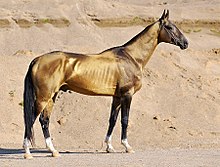
Back أخال تيكي Arabic Ahaltəkə atı Azerbaijani Аһалтәкә аты Bashkir Cavall Akhal-Teke Catalan Achaltekinský kůň Czech Ахалтек лаши CV Achal-Tekkiner German Aĥalteko Esperanto Akhal-Teke Spanish Ahhal-tekiini hobune Estonian
 | |
| Country of origin | Turkmenistan |
|---|---|
| Standard | |
| Traits | |
| Weight |
|
| Height |
|
| Distinguishing features | Riding horse bred for endurance; noted for 'metallic' coat of some individuals |
The Akhal-Teke (/ˌækəlˈtɛk/ or /ˌækəlˈtɛki/; from Turkmen Ahalteke, [axalˈteke]) is a Turkmen horse breed.[1] They have a reputation for speed and endurance, intelligence, and a distinctive metallic sheen. The shiny coat of the breed led to their nickname, "Golden Horses".[2] These horses are adapted to severe climatic conditions and are thought to be one of the oldest existing horse breeds.[3] There are currently about 6,600 Akhal-Tekes in the world, mostly in Turkmenistan, although they are also found throughout Europe and North America.[4] Akhal is the name of the line of oases along the north slope of the Kopet Dag mountains in Turkmenistan. It has been inhabited by the Tekke tribe of Turkmens.
There are several theories regarding the original ancestry of the Akhal-Teke, some dating back thousands of years. The Akhal Teke is probably a descendant of an older breed known as the Turkoman horse, and some claim it is the same breed. The tribes of Turkmenistan selectively bred the horses, recording their pedigrees orally and using them for raiding. The breed was used in the losing fight against the Russian Empire and was subsumed into the Empire along with its country. The Turkoman has influenced many other breeds, including modern warmbloods, and recent research confirms that Turkoman stallions made significant contributions to the development of the Thoroughbred.[5] However, there also exists the possibility that all Akhal-Tekes today have a Thoroughbred sire line.[6] The studbook was closed in 1932.[7] The Soviet Union printed the first breed registry in 1941, including over 700 horses.
- ^ "Permanent Mission of Turkmenistan to the United Nations, Country Facts". Un.cti.depaul.edu. Archived from the original on May 9, 2008. Retrieved June 12, 2007.
- ^ Metallic Sheen as Observed in Individuals of the Akhal-Teke Breed; By Danielle Westfall, Zoology major, Ohio Wesleyan University Archived December 3, 2013, at the Wayback Machine
- ^ Cieslak, Michael, et al. "Origin and history of mitochondrial DNA lineages in domestic horses." PLoS One 5.12 (2010): e15311. "Eleven out of these 39 haplotypes were lineages that were confined to a single primitive breed (B/Arabian; D2d/Cheju; G1/Akhal Teke; H/Garrano; H1/Marismeno; H1a/Lusitano; K2b1/Sicilian Oriental Purebred; K3b/ Yakut; X1/Pottoka; X2a/Debao; X3c/Lusitano; X5/Fulani). " Cieslak, Michael; Pruvost, Melanie; Benecke, Norbert; Hofreiter, Michael; Morales, Arturo; Reissmann, Monika; Ludwig, Arne (2010). "Origin and History of Mitochondrial DNA Lineages in Domestic Horses". PLOS ONE. 5 (12): e15311. Bibcode:2010PLoSO...515311C. doi:10.1371/journal.pone.0015311. PMC 3004868. PMID 21187961.
- ^ 01.10.2012, 1st Report from WATO President Christoph Vogel Archived December 3, 2013, at the Wayback Machine, The breed of Akhal-Teke is facing a crisis: "In her world census for 2012, Jessica Eile-Keith estimated a world population of about 6’600 Akhal-Teke: Turkmenistan ± 3’000, Russia ± 1’600, Central Asia ± 300, USA ± 450, Western Europe ±1’300. With a total of 6’600 Akhal-Teke, one or two specialisation would be justifiable."
- ^ Wallner, Barbara (July 10, 2017). "Y Chromosome Uncovers the Recent Oriental Origin of Modern Stallions". Current Biology. 27 (13): 2029–2035. doi:10.1016/j.cub.2017.05.086. PMID 28669755.
- ^ Auf den Spuren des Achal-Tekkiners Archived April 15, 2014, at the Wayback Machine
- ^ International Association of Akhal-Teke Breeding (MAAK); OPEN LETTER TO MAAK MEMBERS. Subject: Akhal-Teke studbook Archived August 2, 2013, at the Wayback Machine
© MMXXIII Rich X Search. We shall prevail. All rights reserved. Rich X Search